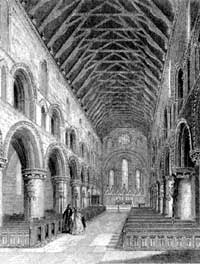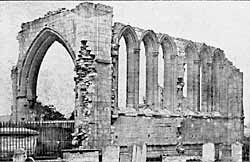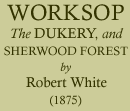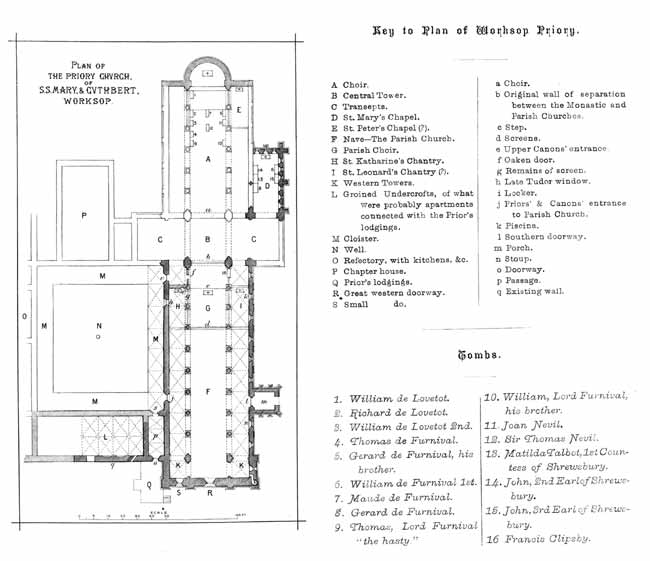< Previous | Contents | Next >
The architecture of the church

Parish church, Worksop.
Part of the original endowment of the Priory was the Parish Church of Worksop—probably a, comparatively speaking, small Norman edifice, terminating in an apse at its eastern end. This must have been rebuilt, or at least remodelled, when William de Lovetot founded his establishment of Augustine Canons at Worksop, but yet not without some reservation in favour of the parishioners.
Not long after, this church was incorporated into, or exchanged for, another of far larger dimensions, erected at two different, but not widely separated, periods, the evidences of which still exist. Of the first period are the two most eastern pillars, and also some features of the south-western angle of the now detached Lady Chapel; of the second, the greater portion of the existing fabric. The former were a part of a second greatly enlarged church, erected no doubt by the aid of Richard de Lovetot the son of the founder, who, there is reason to suppose, commenced the rebuilding of the same about 1150-60, to which date the earlier features of the existing edifice belong. He appears also to have re-dedicated the church to the Virgin as well as to St. Cuthbert, judging from the evidence of his son William’s confirmatory charter, wherein we for the first time find the name of St. Mary, coupled with that of St. Cuthbert, in connexion with the Priory. And there would be reason for this;. for, when the church was enlarged, it was doubtless found convenient to take that opportunity of apportioning one part of its area to the parochial use, and the other to that of the canons. On this occasion, either from the original dedication of the old parish church, or from a new preference, the people of Worksop might wish to hear their portion of the new fabric at least called by the name of St. Mary, while the canons would naturally wish to retain that of St. Cuthbert.
An interval then elapsed before the works connected with the church were resumed, as intimated by its architectural testimony, almost the whole of the present fabric being of the last quarter of the 12th century, and probably of the date 1170-80, when William de Lovetot the second, son of Richard, was lord of Worksop, and almost as surely the great promoter of, if not the actual builder of this fine fabric. Then certainly, if not before, a separation of the area of the church took place: the nave being assigned to the parishioners, the choir to the canons of the Priory; to a certain extent each then constituting a separate church, yet combining to present the usual form of a large conventual church, 265 feet long, external measurement.—[See the Plan below.]

Lady Chapel, Worksop Priory (c. 1900).
The choir, or Priory church, probably of six bays, had an eastern apse, and north and south aisles, not carried round the apsidal end of the choir, but terminating in flat walls. The high altar, doubtless, stood within the apse, and was approached by several steps; in the presbytery the principal benefactors of the Priory were buried, as indicated on the Plan, arranged by the aid of Pigot’s descriptive chronicle. To the conventual church a most beautiful addition was made, about 1240-50, and probably in a great measure through the liberality of Maude de Lovetot, in her old age. This was a pure Early English chapel, dedicated to the Virgin Mary, and commonly called the Lady Chapel. It was attached to the eastern side of the south transept and the western portion of the south aisle wall, communicating with the former by a single arch, and with the latter by two arches supported by a central pillar and responds. Its roof was vaulted, as indicated by the remaining springers, &c., but this has long since fallen in. Its graceful line of shafted lancet windows on the south, divided into two groups of three in each, and also its eastern triplet are admirable. The sill of the middle window of this last is much higher than those of the others, from its position over a buttress; internally the blank space thereby occasioned was probably concealed by a shrine, ciborium, or piece of sculpture. The aumbrey, double piscina, and sedile of this chapel are still in a good state of preservation; and its remaining features, generally, are so excellent, its details so purely designed, that it would be difficult to find a better model for a small modern church.
We have now to search for another chapel, dedicated to St. Peter, that was on the side of the choir, and adjoining it, according to Pigot. These conditions will be fulfilled by the space [E] on the Plan, included within the two easternmost bays of the south aisle, if duly chancelled off from the choir and the remainder of that aisle; and there, in all probability, was St. Peter’s Chapel.
The area of the central tower, in combination with that of the transepts, occupied a space of one hundred feet from north to south; this, not improbably, formed an ante-church to the conventual choir, or at all events was esteemed a portion of the Priory church,—a connexion that seems to be pointed to by the destruction of these features, in common with the choir.
And now let us examine what may be termed the Nave of Worksop Church, if regarded as a whole, but which was also a complete parochial church before the Reformation, as well as at present.
It is one hundred and forty feet long and sixty feet wide, external measurement. On entering, the effect of its unbroken aisle-arcades, supported by eight solid alternately octangular and circular shafted pillars, is very imposing; while the long range of the triforium arches above, together with the arcade work between them, adds much to the beauty of the interior.
A low wall, or solid reredos, must always have existed at the east end, within the central tower arch; and some indications of the former still appear in the non-continuance of the tower-arch shafts to the ground, as though they had formerly rested upon, or were connected with, a wall at their respective bases.
The first pair of pillars are not only of an earlier date than the others, but they rise from a slightly higher level. A step between these probably marked the limit of the parochial church sacrarium; but its choir extended two bays further to the west, and was partitioned off from the remainder and from the aisles by screens. Over the one between the choir and the nave was a rood-loft, alluded to several times in churchwardens’ accounts, viz., "Anno 1564; It for takyng downe of the Rode-lofte, xjjd ;" but this appears to have been only some portion of the same, for in 1570 again appears a similar entry; "It for ale and bread and to workmen at the takyng downe of the rode-loft, ijs ;...... It to the paynter, for paynting the rode-lofte before it was takyn down ,........ It. received of Mr. Vycar for tymber of the rode loft, vj.. viijd. Nevertheless the screen was still left intact, another item in the following year’s account pointing to this, viz
"To Mychacll Hardye for makyng a crest for the roode lofte iiis ijd." This was done in accordance with Archbishop Grindal’s visitation directions, "that the rood-screen be left to separate the chancel from the nave, and instead of the rood-loft some convenient crest be put upon it."

